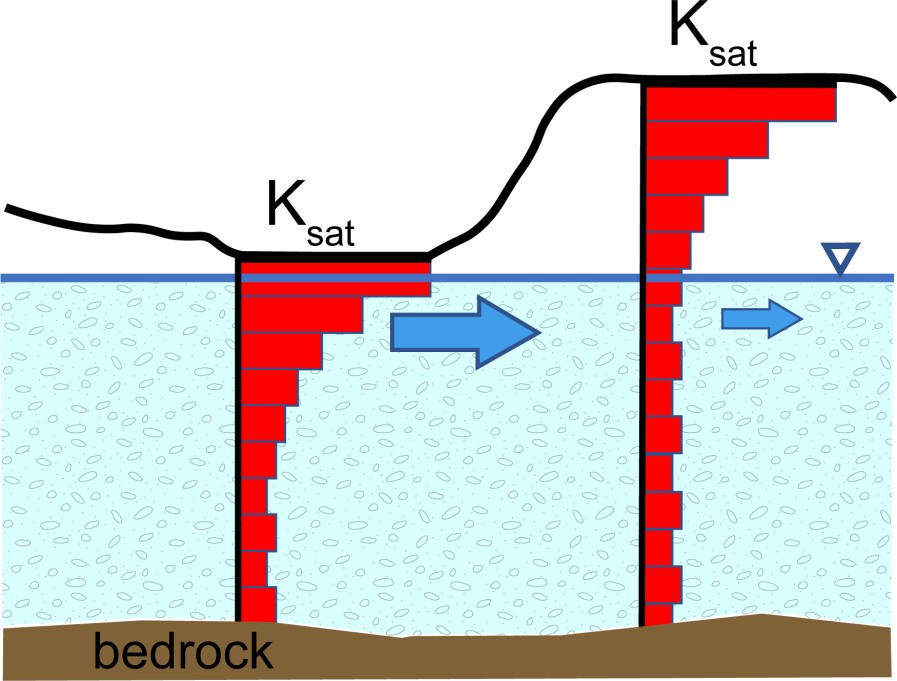4.2 Transport in Peatlands
In peatlands with pronounced declines in hydraulic conductivity with depth and associated distribution of micro and macropores can induce large scale solute transport patterns. In near surface high hydraulic conductivity peat, solute transport follows that of water flow, with a large proportion (> 90 percent) of the total mass flux often transported within the upper few decimeters (McCarter and Price, 2017b). This is illustrated by the dissolved solutes. Due to the low dispersivity of these near surface pore networks, the resulting solute plumes are often elongated and narrow, both vertically and horizontally (Hoag and Price, 1995; McCarter and Price, 2017b).
Although local preferential flow paths, such as those created by layering of peat with different decomposition states, or roots, can induce solute fluxes well beyond that expected of the primary solute plume (Baird and Gaffney, 2000; McCarter and Price, 2017b), these are typically localized in their impact. As the hydraulic conductivity decreases to a more uniform value with depth, solute plumes are transported through a greater proportion of the peat aquifer. Thus, knowledge of the shape of the transmissivity profile is critical to understanding solute transport in peatlands.
In many peatlands, the surface topography is not uniform. The hummock—hollow topography that is a defining feature in many peatlands, notably bogs, leads to regions of preferential flow and transformation of solutes. Within the hollows, the near-surface hydraulic conductivity is higher than that at an equivalent elevation beneath adjacent hummocks. This lateral distribution of hydraulic conductivity results in preferential solute transport within and between the hollows, while limited lateral transport occurs through hummocks (Balliston et al., 2018). This inter-hollow transport occurs both as overland flow and in the near subsurface, where the hydraulic conductivity of near surface peat in hollows is typically high (Figure 18).

Figure 18 – Identical (arbitrary) hydraulic conductivity profiles with depth below the surface under a hollow (left) and hummock (right) result in much higher transmissivity beneath hollows when the water table is near the hollow surface. Similarly shaped hydraulic conductivity profiles are observed in fen ridge and flark systems as shown in Figure 4.
Although the permeability is typically lower in hummocks at the same plane as the peat in adjacent hollows, lateral solute transport still occurs. Within the hummocks, the available organic matter and longer residence times increase the potential for biogeochemical reactions and sequestration of contaminants. While the hummock—hollow topography is typically associated with Sphagnum-dominated peatlands, tussocks can form from dense groupings of sedges within sedge dominated peatlands, which are functionally comparable to the previously discussed hummocks. Hence, most solute transport is routed around tussocks. This complicated routing of solutes in peatlands makes accurately predicting solute plume development difficult.
Peatlands with distinct directional flow, such as ladder and northern ribbed fens (sometimes referred to as aapa mires, in Europe), often have a peat ridge—flark surface (e.g., Figure 4), or ridge—pool topography (e.g., Figure 7). Peat ridges are areas of elevated peat mounds, similar to hummocks, but they are linear and water flow is perpendicular to the peat ridges. Flarks are flat expanses of moss or sedges where the water table is near or above the surface. The spatial variation of the water table depth in relation to the near surface peat or the height of the water surface above the ground facilitates periods of extremely high solute transport rates during high water table periods. The majority of solutes are preferentially transported in these highly permeable groundwater layers or surface water (McCarter and Price, 2017b).
During high water table periods, solute transport is rapid, with rates on the order of hundreds of meters per day, which is extremely high for peatlands. However, the presence of open water pools that bisect these surface flow conducting peatlands can increase or decrease solute transit time, depending on mixing and storage of solutes, increased/decreased biogeochemical reactions, or preferential flow within the pools (McCarter and Price, 2017b). Similar to other peatlands, during low flow periods the water table resides within the lower hydraulic conductivity deeper peat and solute transport decreases exponentially, greatly reducing downgradient connectivity.
The peat—pool topography also alters the reactivity of different solutes (McCarter et al., 2017). Many redox sensitive or metal chemical species will be preferentially removed in the peat ridges, rather than in the pools, due to the abundance of organic matter (peat) in the ridges. While in the pool, nutrients such as nitrate or phosphate can be preferentially removed from the water column through algae uptake or other biochemical processes that are dependent on sunlight. Thus, the mobility of any given solute in these systems will not only depend on the hydrological transport rates but also on the partitioning between surface water and subsurface reaction rates at the peatland scale. It is this combination of water table-dependent transport and high spatial heterogeneity of reaction rates that makes predicting the pattern of reactive solute plumes in peatlands difficult.
